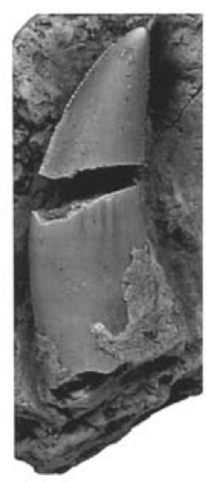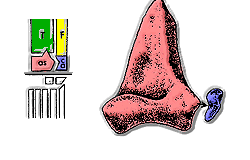|
Avalonianus
''Avalonianus'' is a highly dubious and possibly invalid genus of archosaur from the Late Triassic of England. It was first described in 1898 by Harry Seeley with the name ''Avalonia'',H. G. Seeley. 1898. On large terrestrial saurians from the Rhaetic Beds of Wedmore Hill, described as ''Avalonia sanfordi'' and '' Picrodon herveyi''. Geological Magazine, decade 4 5:1-6 but that name was preoccupied (Walcott, 1889), so Oskar Kuhn renamed it in 1961, albeit with no epithet (although Seeley added the epithet ''sanfordi'' in 1898). It was thought to be a prosauropod, but later analysis revealed it was actually a chimera, with the original teeth coming from a non-dinosaurian ornithosuchian (or possibly an early theropod Theropoda (; ), whose members are known as theropods, is a dinosaur clade that is characterized by hollow bones and three toes and claws on each limb. Theropods are generally classed as a group of saurischian dinosaurs. They were ancestrally c ...), and later-refe ... [...More Info...] [...Related Items...] OR: [Wikipedia] [Google] [Baidu] |
Camelotia
''Camelotia'' (meaning "from Camelot") is a genus of sauropodomorph dinosaur from the Late Triassic or Early Jurassic in what is now England. Paleontologists are divided on which family it may belong to; in the past, ''Camelotia'' has generally been assigned to the prosauropods, but this group of primitive dinosaurs is in constant flux. The genus is now considered a member of the family Melanorosauridae, which includes the first true giant herbivorous dinosaurs.Galton, P. M. (1985). Notes on the Melanorosauridae, a family of large prosauropod dinosaurs (Saurischia: Sauropodomorpha). Geobios, 18(5), 671-676. Discovery and species The type specimens, syntypes SAM 3449 and SAM 3450, were described and named in 1985 by Galton. They were collected from the Triassic-Jurassic Westbury Formation, dating to the latest Rhaetian-Lowermost Hettangian. The fossils includes the specimens "BMNH R2870-R2874", "R2876-R2878" (holotype), with vertebrae, ribs, and parts of the pubis, isch ... [...More Info...] [...Related Items...] OR: [Wikipedia] [Google] [Baidu] |
Picrodon
''Picrodon'' is the name given to a genus of archosaur, possibly a sauropodomorph dinosaur, from the Rhaetian of England which was possibly synonymous with the dubious archosaur ''Avalonianus''. The type, and only species, ''P. herveyi'', was named in 1898.H. G. Seeley. 1898. On large terrestrial saurians from the Rhaetic Beds of Wedmore Hill, described as '' Avalonia sanfordi'' and ''Picrodon herveyi''. Geological Magazine, decade 4 5:1-6 Discovery and naming In 1894, W. A. Sanford described the fossil remains of what he considered to be two large reptiles discovered near Westbury-on-Severn, Glastonbury (Westbury Formation) by Eev. Sydenham H. A. Hervey and Sanford himself.''Proceedings of the Somerset Archaeological Society'' - vol. xl, 1894, p. 234 Harry Govier Seeley described the fossils and named two genera: ''Avalonia'' (preoccupied; now ''Avalonianus'') and ''Picrodon''; both are based solely on teeth. Only a single tooth, holotype BMNH R2875, belonging to ''P. herveyi ... [...More Info...] [...Related Items...] OR: [Wikipedia] [Google] [Baidu] |
Picrodon Holotype Tooth
''Picrodon'' is the name given to a genus of archosaur, possibly a sauropodomorph dinosaur, from the Rhaetian of England which was possibly synonymous with the dubious archosaur '' Avalonianus''. The type, and only species, ''P. herveyi'', was named in 1898.H. G. Seeley. 1898. On large terrestrial saurians from the Rhaetic Beds of Wedmore Hill, described as '' Avalonia sanfordi'' and ''Picrodon herveyi''. Geological Magazine, decade 4 5:1-6 Discovery and naming In 1894, W. A. Sanford described the fossil remains of what he considered to be two large reptiles discovered near Westbury-on-Severn, Glastonbury (Westbury Formation) by Eev. Sydenham H. A. Hervey and Sanford himself.''Proceedings of the Somerset Archaeological Society'' - vol. xl, 1894, p. 234 Harry Govier Seeley described the fossils and named two genera: ''Avalonia'' (preoccupied; now '' Avalonianus'') and ''Picrodon''; both are based solely on teeth. Only a single tooth, holotype BMNH R2875, belonging to ''P. her ... [...More Info...] [...Related Items...] OR: [Wikipedia] [Google] [Baidu] |
Chimera (paleontology)
In paleontology, a chimera is a fossil that was reconstructed with elements coming from more than a single species or genus of animal. In other words they are mistakes or sometimes hoaxes made by paleontologists, putting together parts that do not come from the same organism. A now classic example of chimera is ''Protoavis''. List of paleontological chimeras * Archaeoraptor * ''Dalianraptor''? * ''Lametasaurus''? * ''Protoavis'' * Piltdown Man * ''Ultrasauros'' * ''Ornithopsis hulkei'' * Teihivenator * ''Dakotaraptor''? * ''Avalonianus'' * ''Kootenichela''? * ''Polacanthoides''?Nopcsa, F. (1928), "Palaeontological notes on reptiles." Geologica Hungarica, Series Palaeontologica, tomus, 1, -Pasc. 1, p. 1-84 References Paleontological chimeras, {{paleo-stub ... [...More Info...] [...Related Items...] OR: [Wikipedia] [Google] [Baidu] |
Archosaur
Archosauria () is a clade of diapsids, with birds and crocodilians as the only living representatives. Archosaurs are broadly classified as reptiles, in the cladistic sense of the term which includes birds. Extinct archosaurs include non-avian dinosaurs, pterosaurs, and extinct relatives of crocodilians. Modern paleontologists define Archosauria as a crown group that includes the most recent common ancestor of living birds and crocodilians, and all of its descendants. The base of Archosauria splits into two clades: Pseudosuchia, which includes crocodilians and their extinct relatives, and Avemetatarsalia, which includes birds and their extinct relatives (such as non-avian dinosaurs and pterosaurs). Older definitions of the group Archosauria rely on shared morphological characteristics, such as an antorbital fenestra in the skull, serrated teeth, and an upright stance. Some extinct reptiles, such as proterosuchids and euparkeriids, possessed these features yet originated pri ... [...More Info...] [...Related Items...] OR: [Wikipedia] [Google] [Baidu] |
Late Triassic
The Late Triassic is the third and final epoch (geology), epoch of the Triassic geologic time scale, Period in the geologic time scale, spanning the time between annum, Ma and Ma (million years ago). It is preceded by the Middle Triassic Epoch and followed by the Early Jurassic Epoch. The corresponding series (stratigraphy), series of rock beds is known as the Upper Triassic. The Late Triassic is divided into the Carnian, Norian and Rhaetian Geologic time scale, Ages. Many of the first dinosaurs evolved during the Late Triassic, including ''Plateosaurus'', ''Coelophysis'', and ''Eoraptor''. The Triassic–Jurassic extinction event began during this epoch and is one of the five major mass extinction events of the Earth. Etymology The Triassic was named in 1834 by Friedrich August von Namoh, Friedrich von Alberti, after a succession of three distinct rock layers (Greek meaning 'triad') that are widespread in southern Germany: the lower Buntsandstein (colourful sandstone'')'', t ... [...More Info...] [...Related Items...] OR: [Wikipedia] [Google] [Baidu] |
Late Triassic Reptiles Of Europe
Late may refer to: * LATE, an acronym which could stand for: ** Limbic-predominant age-related TDP-43 encephalopathy, a proposed form of dementia ** Local-authority trading enterprise, a New Zealand business law ** Local average treatment effect, a concept in econometrics Music * ''Late'' (album), a 2000 album by The 77s * Late!, a pseudonym used by Dave Grohl on his ''Pocketwatch'' album * Late (rapper), an underground rapper from Wolverhampton * "Late" (song), a song by Blue Angel * "Late", a song by Kanye West from ''Late Registration'' Other * Late (Tonga), an uninhabited volcanic island southwest of Vavau in the kingdom of Tonga * "Late" (''The Handmaid's Tale''), a television episode * LaTe, Oy Laivateollisuus Ab, a defunct shipbuilding company * Late may refer to a person who is Dead See also * * * ''Lates'', a genus of fish in the lates perch family * Later (other) * Tardiness * Tardiness (scheduling) In scheduling, tardiness is a measure of a delay in exe ... [...More Info...] [...Related Items...] OR: [Wikipedia] [Google] [Baidu] |
Prehistoric Archosaurs
Prehistory, also known as pre-literary history, is the period of human history between the use of the first stone tools by hominins 3.3 million years ago and the beginning of recorded history with the invention of writing systems. The use of symbols, marks, and images appears very early among humans, but the earliest known writing systems appeared 5000 years ago. It took thousands of years for writing systems to be widely adopted, with writing spreading to almost all cultures by the 19th century. The end of prehistory therefore came at very different times in different places, and the term is less often used in discussing societies where prehistory ended relatively recently. In the early Bronze Age, Sumer in Mesopotamia, the Indus Valley Civilisation, and ancient Egypt were the first civilizations to develop their own scripts and to keep historical records, with their neighbors following. Most other civilizations reached the end of prehistory during the following Iron Age. T ... [...More Info...] [...Related Items...] OR: [Wikipedia] [Google] [Baidu] |
Theropod
Theropoda (; ), whose members are known as theropods, is a dinosaur clade that is characterized by hollow bones and three toes and claws on each limb. Theropods are generally classed as a group of saurischian dinosaurs. They were ancestrally carnivorous, although a number of theropod groups evolved to become herbivores and omnivores. Theropods first appeared during the Carnian age of the late Triassic period 231.4 million years ago ( Ma) and included all the large terrestrial carnivores from the Early Jurassic until at least the close of the Cretaceous, about 66 Ma. In the Jurassic, birds evolved from small specialized coelurosaurian theropods, and are today represented by about 10,500 living species. Biology Diet and teeth Theropods exhibit a wide range of diets, from insectivores to herbivores and carnivores. Strict carnivory has always been considered the ancestral diet for theropods as a group, and a wider variety of diets was historically considered a characteri ... [...More Info...] [...Related Items...] OR: [Wikipedia] [Google] [Baidu] |
Oskar Kuhn
Oskar Kuhn (7 March 1908, Munich – 1990) was a German palaeontologist. Life and career Kuhn was educated in Dinkelsbühl and Bamberg and then studied natural science, specialising in geology and paleontology, at the University of Munich, from which he received his D. Phil. in 1932. He worked in the University of Munich Geological Institute, among other things on the ''Fossilium Catalogus'' (Catalogue of Fossils), and then in 1938 on a stipend from the Deutsche Forschungsgemeinschaft, moved to the University of Halle, where he worked on the Geiseltal fossils. In 1939 he achieved his Habilitation with a thesis on the Halberstadt Keuper fauna, and in 1940 was named Privatdozent in geology and paleontology. Informed by his Catholic religion, Kuhn was an exponent of idealistic morphology: he viewed evolution as operating only within predetermined morphological classes. In 1943 he declared, "The theory of descent has collapsed." After a political conflict with his mentor, Johan ... [...More Info...] [...Related Items...] OR: [Wikipedia] [Google] [Baidu] |
Ornithosuchian
Avemetatarsalia (meaning "bird metatarsals") is a clade of diapsid reptiles containing all archosaurs more closely related to birds than to crocodilians. The two most successful groups of avemetatarsalians were the dinosaurs and pterosaurs. Dinosaurs were the largest terrestrial animals for much of the Mesozoic Era, and one group of small feathered dinosaurs (Aves, i.e. birds) has survived up to the present day. Pterosaurs were the first flying vertebrates and persisted through the Mesozoic before dying out at the Cretaceous-Paleogene (K-Pg) extinction event. Both dinosaurs and pterosaurs appeared in the Triassic Period, shortly after avemetatarsalians as a whole. The name Avemetatarsalia was first established by British palaeontologist Michael Benton in 1999. An alternate name is Panaves, or "all birds", in reference to its definition containing all animals, living or extinct, which are more closely related to birds than to crocodilians. Although dinosaurs and pterosaurs were th ... [...More Info...] [...Related Items...] OR: [Wikipedia] [Google] [Baidu] |




